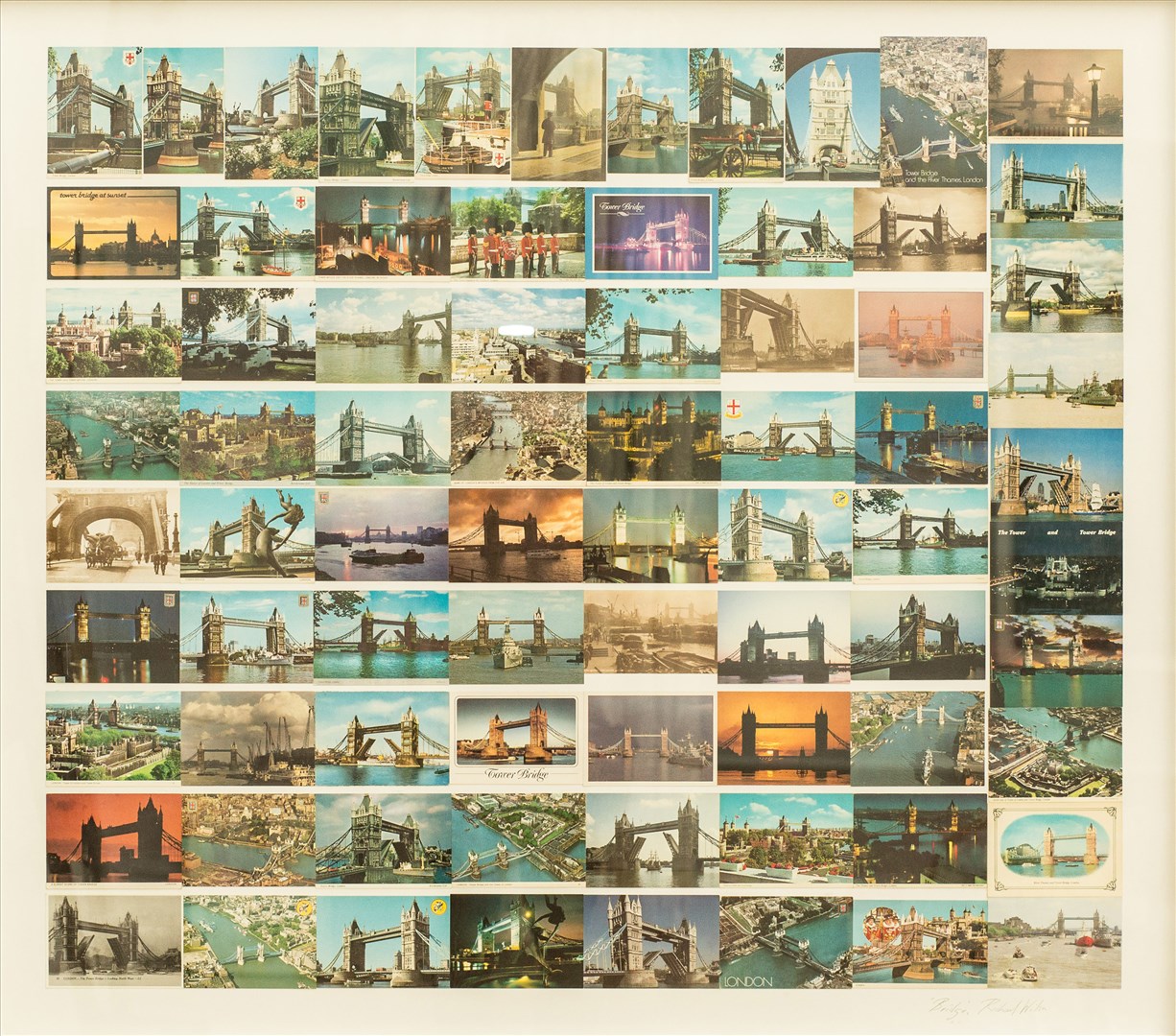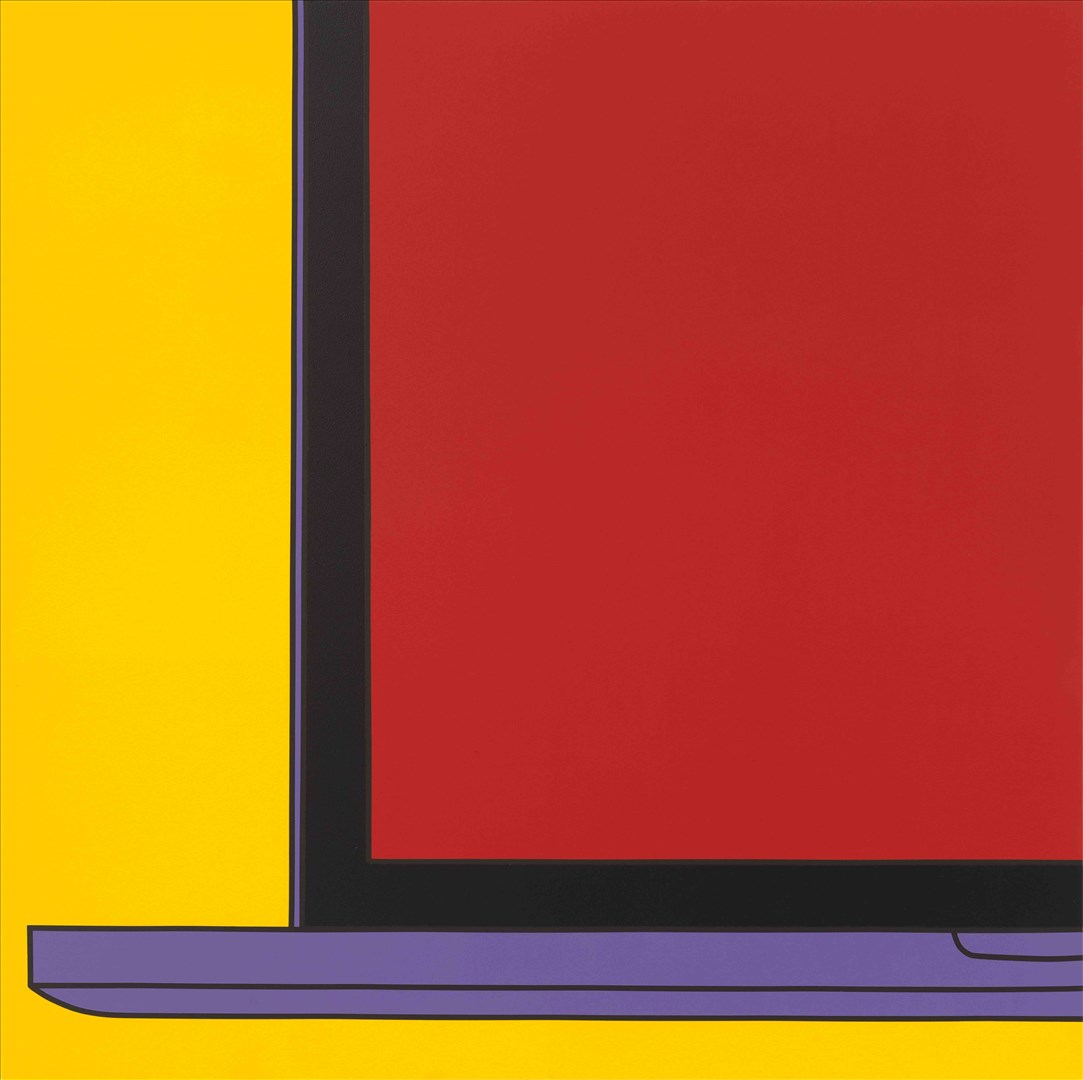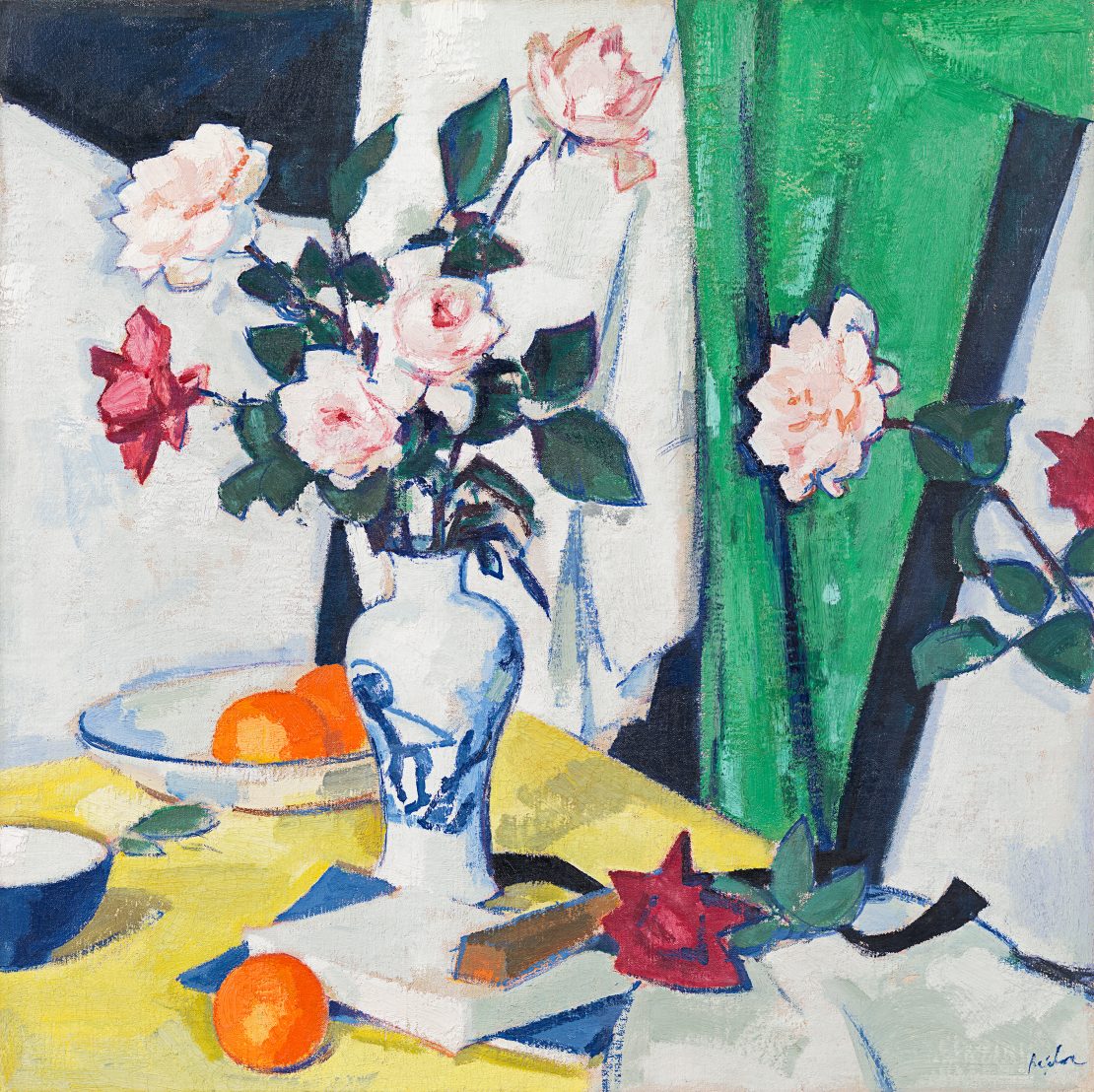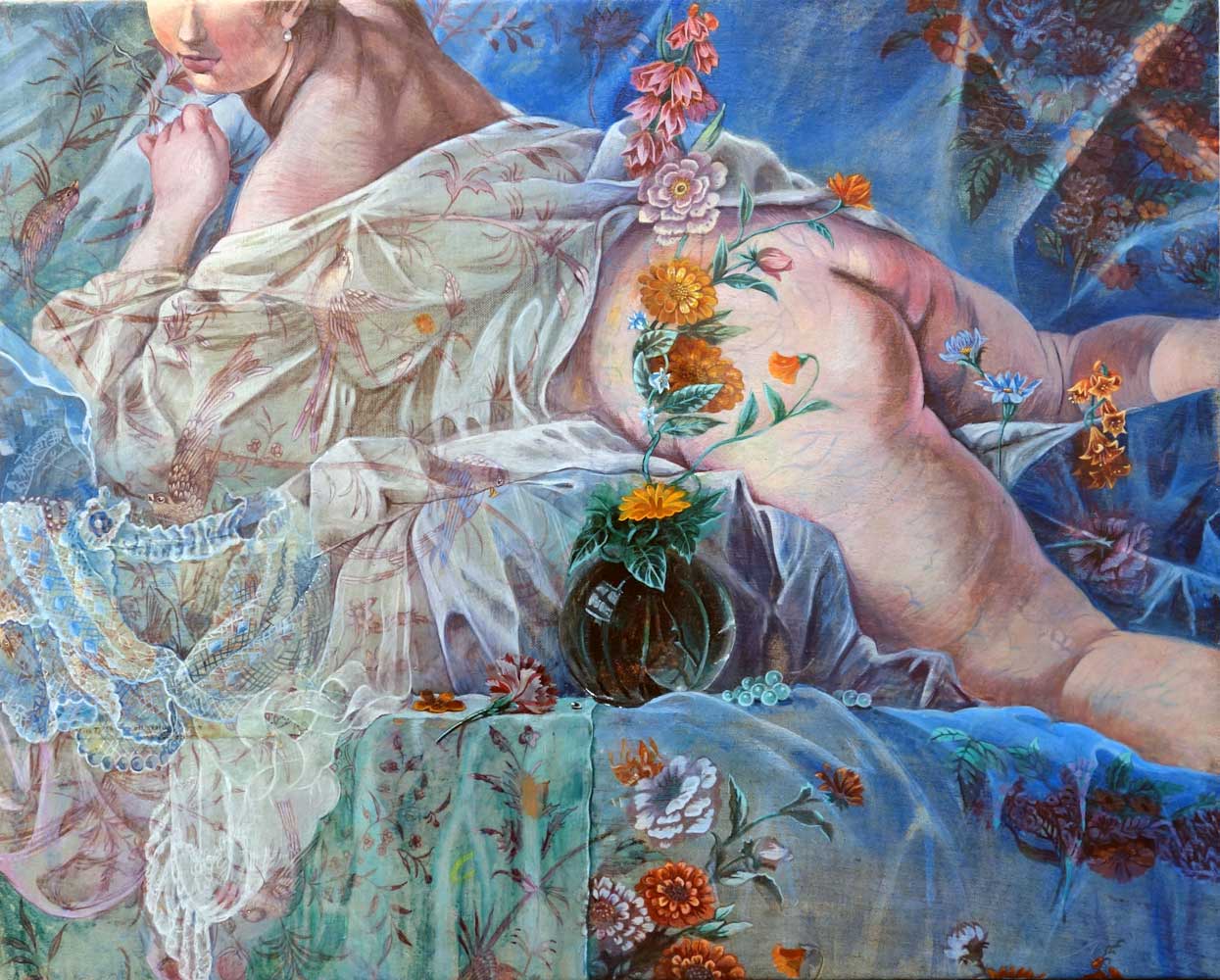'How to Look at the Royal Academy Summer Show': Paul’s ART STUFF ON A TRAIN 220
Ah, the RA Summer show! People insist on assessing it as if it
were an exhibition, when it is essentially an Art Fair: one without
gallerists, but with the usual features of variable quality, too much to
take in, and visual incoherence. As such, there will of course be
plenty to annoy you, but you will also have, every now and again, one of
the best fair experiences – you see a work, wonder who made it, are
surprised to find it was x. But then you think yes, that makes sense as
an extension of their practice. Here are four such experiences from this
year’s admittedly larger volume of ‘not another of those’ moments:
No. 747 Carol Robertson – ‘Pointstar – Magenta’: Oil on canvas, 50 x 50 cm, £4,000 (sold)
Carol Robertson has long used the wholeness and completion of the circle to explore colour and form in delicately radiant colours. So you might not recognise a dynamically pointed and gently throbbing star as hers – but she arrived at it from a circle, and as she says ‘the points of a star hugely increase that external line as one follows the radiations outwards from their luminous centre-point’.
No 499: David Nash – ‘Red Over Black’: Pastel on paper in charred frames, 159 x 223 cm, £24,000
I might not have linked David Nash with this intense duochrome, but for the frames: he’s known for his sculptures using burnt (as well as unburnt) wood. So it’s as if, in an attractive paradox, it’s not the work itself but how it is framed which makes it the artist’s work, so it would be worth very little indeed if unframed.
No 949: Richard Wilson – Bridge: Postcards on paper, 132 x 116 cm, £12,000
Richard Wilson is known for installations which transform buildings, such as the revolving ‘Turning the Place Over’ (2007) in Liverpool. Postcards of Tower Bridge seem a long way from that, but there’s a suggestion that the structure could be seen as a proto-Wilson. So is £12,000 pretty reasonable for large work by a major artist, or rather pricy at £159 each for 80 common enough postcards?
No. 13: Michael Craig-Martin – ‘Untitled (Yellow Laptop Fragment)’: Acrylic on aluminium, 90 x 90 cm, £40,000 (sold)
The sharply delineated, intensely coloured objects of Michael Craig-Martin, who curated the summer show a couple of years back, are pretty distinctive. If we can understand the quality of ordinary things, he has said, ‘we are closer to the substance of life’. But I’ve not seem an item as partial and abstracted as this laptop, which pushes tellingly at the boundary of recognisability.
‘Bricked In‘: Paul’s ART STUFF ON A TRAIN 219
 Monique Frydman installation view
Monique Frydman installation viewParasol unit’s USP is to give foreign artists not just their first UK show, but a very substantial one. Just so, thirty years of the French painter Monique Frydman arrive fully formed over both floors (to 12 Aug). Frydman was a friend of Joan Mitchell’s, and I can see how she could be dismissed as on overly polite peddler of ersatz Ab Ex. The paintings’ interest, though, is in their narratives. There’s a treble sense of memorialisation: first because they are derived with some finesse from time-honoured painters (Monet, Bonnard and Sassetta make explicit appearances); second because she starts by making frottage over spools of rope, the traces from which remain; and third because the paintings often conjure peering into pools (or, in the case of ‘L’Absinthe’, an alcoholic haze). Put that together with the biographical fact that Frydman, a Jew, was born in hiding in 1943, and it’s easy to see her as turning away from reality in an explicit enough way to speak, indirectly, of its horrors. Frydman was an explicitly political artist in her youth, and there’s also a push and pull between what might traditionally be seen as male (heroic scale with aggressive means of making marks) versus female (pastel colours, lyrical outcomes with echoes of tapestry). So much the worse, as I read that, for such conventions. In formal terms, it’s the ‘Witness’ series which do this most radically, by improbably alternating brick and canvas. Back with the suppression of memory, these innovative works also suggest, via their title, that something precious has been bricked in. It’s a powerful implication.

Monique Frydman: ‘Witness’ series

Monique Frydman: ‘L’Absinthe’, 1989
Most days art Critic Paul Carey-Kent spends hours on the train, traveling between his home in Southampton and his day job in London. Could he, we asked, jot down whatever came into his head?
‘Skin in the Game’: Paul’s ART STUFF ON A TRAIN #218

In the immediate post-YBA years you used to hear of people opting for art as a financially promising ‘career option’, rather than a passion. Whether they did or not, the opposite of that type must be 83 year old Indian Mali. He gets to plenty of other people’s shows, and his own 30th solo presentation is at the for-hire Espacio Gallery (159 Bethnal Green Road) to 11 June. ‘Ink on the Body, Ink on the Paper’ is lightly conceptual fun. Mali has focused on book reading as a subject for many years. One series shows readers of books of paintings echoed in the image, and Frida Kahlo receives such a tribute here. For the most part, though, in another paradoxically non-verbal spin on the theme, we see women with tattoos ‘reading’ a book of tattoo designs. The images have a self-generating genesis: Mali meets his subjects, most of whom are themselves artists, at his own openings. Over the past five years, whenever he’s seen a likely tattoo bearer he’s proposed a posing session in the back of the gallery. Not surprisingly, then, several of his models were present, including one who came with the tattooist responsible for her yin / yang double crow image, and another whose back displays the whole of ee cummings’ sonnet starting ‘i like my body when it is with your / body’. Her pose reversed the image-book norm so that – in cummings’ words – ‘it is so quite new a thing’.

‘Surprised by Paintings’: Paul’s ART STUFF ON A TRAIN #217
Several current shows of paintings took me by surprise…

Wayne Thiebaud: ‘Fall Fields’, 2017
Wayne Thiebaud is a favourite of mine from American viewings: now White Cube Mason’s Yard has (to 2 July) more of him than London has seen before. The gallery has been moving from YBAs towards OFPs (Old Foreign Painters), recently showing Anselm Kiefer (72), Larry Bell (77) and Park Seo-bo (86). Thiebaud, though, is 96 – but he looked none the worse for it at the opening, and this creamily typical landscape was painted this year.
SJ Peploe: ‘Still life of pink & red roses in a Chinese vase’ c 1918-22
SJ Peploe would be 164 were he still alive, but that’s not the surprise at Richard Green – the Scottish colourist died in 1935. Rather, it’s that the gallery has managed to track down 24 very fresh-looking examples from such a popular artist, including 13 of his favourite subject of roses.

Augusto Bonalumi: ‘Blue’, 1970
Milan’s Cardi Gallery opened a London base on Grafton Street, Mayfair a few months ago. It looks modest from outside but actually has five floors of high value, mostly Italian, work, making it much the tallest private gallery space in London! This subtle Bonalumi a la Klein has just the one tweaked corner to give the game away.
Lo Spadino: ‘Allegory of the Seasons (3)’, c. 1700
There’s older Italian fare at Colnaghi’s new rooms, most strikingly at present a set of four infectiously absurd anthropomorphic still-life paintings of the seasons by the Roman Giovanni Paolo Castelli, nicknamed Lo Spadino (1659-1730). They cheekily crank up, fifty years on, the famous manner of Arcimboldo’s masterpieces with, I suppose – if ‘spadino’ is ‘sword’ – rapier wit.

Terry Rodgers & Lalique: 'Sirènes', 2017
I like it when contemporary art crops in less expected places. Just so, the window display of the Lalique store on Conduit Street, Mayfair currently showcase new crystal work by Terry Rodgers. The American artist’s lushly painted, edge-of-queasy scenes of bacchanalian excess among beautiful people tread a tantalising line between exposure of – or complicity with – excess and inequality. Works such as ‘The Palace of Automorphic Delights’ are fictions presented as realism, through which Rodgers looks to render what he calls the ‘delicate balance between our inner and outer lives’. That translates well into crystal, he believes, as that ‘acts as a mirror whose distorting reflections reveal hidden aspects of reality’. Rodgers has updated the classic 1927 Bacchantes vase created by Rene Lalique (1860-1945), paying tribute to the female followers of Bacchus, god of wine. They were said to be wild, intoxicated women apt to tear animals to pieces, though Lalique depicted them rather gracefully. So does Rodgers, in his ‘Sirènes’ reinterpretation composed – as his paintings are – by combining various photos he’s taken of models posing in the studio. On the vases they wear only jewellery, with the bling highlighted in aluminium on the more expensive editions. Crystal, in case – like me – you weren’t too sure, is glass with an admixture of lead oxide which generates a higher refractive index than ordinary glass, the effect of which is added sparkle.

René Lalique: Bacchantes Vase, 1927

Terry Rodgers: ‘The Palace of Automorphic Delights’, 2009 – 84″ x 126″, oil on linen
Most days art Critic Paul Carey-Kent spends hours on the train, traveling between his home in Southampton and his day job in London. Could he, we asked, jot down whatever came into his head?
‘The One with LeWitt’: Paul’s ART STUFF ON A TRAIN 214
Kazuko Miyamoto: ‘Stunt (181 Chrystie Street, 1981)’, 1982
This striking lifesized image seems to show a woman, naked except for a mask, taking the piss out of a typical Sol LeWitt. Indeed so: Kazuko Miyamoto was LeWitt’s longtime assistant, and this is her breaking off from fabricating a test piece for him in her own studio. ‘Stunt (181 Chrystie Street, 1981)’ is a unique composite of 44 photocopies, made at a time when that was to push the medium to its limit as well as mimicking the kind of structure typical of her employer’s work. Having seen that, ‘Male I, 1974’ makes a lot of sense: would-be-platonic form meets the use of thread to define space à la Sandback, but the outcome – as the title mockingly implies – is a hairily masculine take on how, in Miyamito’s words, ‘being Japanese you are minimalist anyway’. White Rainbow shows her with Lydia Okumura, another artist of Japanese origin who had a winning way with the use of thread. They worked together in 1970’s New York, where Miyamito was a member of the all-woman gallery A.I.R. for many years. The jocularity, incidentally, was born out of mutual respect: no-one owns more of Miyamoto’s works than LeWitt’s estate. And, with sleek serendipity, you can see a comparable LeWitt from 1972, quite possibly one made by Miyamoto, in one of the opening presentations at Thaddaeus Ropac’s hugely impressive new mega-gallery (though Oliver Beer’s 2D sculptures and voices playing the architecture are the main reasons to visit 37 Dover Street).

Sol LeWitt: ‘123454321’, 1972
Most days art Critic Paul Carey-Kent spends hours on the train, traveling between his home in Southampton and his day job in London. Could he, we asked, jot down whatever came into his head?
'Turn of the Old?' - Paul’s ART STUFF ON A TRAIN 213

Rosalind Nashashibi, still from ‘Vivian’s Garden’, 2017 – a 30 minute exploration of the lives of Vivian Suter and her mother Elisabeth Wild, two Swiss / Austrian émigré artists in living in Panajachel, Guatemala
Perhaps, at 59, I should declare an interest – but I think the Turner Prize has moved in a sensible direction by removing the ‘under 50’ rule, and positioning itself more clearly as a prize for artists whose practice advances significantly in the 12 months of judging, in this case the year to 24 April 2017. Such an advance can occur at any age, and the 2017 year’s shortlist are all over 40: Rosalind Nashashibi (43), Andrea Büttner (45), Hurvin Anderson (52) and Lubaina Himid (62). The nature of the advance and its timing are also, evidently, interpreted flexibly: Nashashibi is recognised not for the making of ‘Electrical Gaza’ (which was shown at the Imperial War Museum in 2015, making it the wrong kind of ‘old’), but for the different way she presented it in Austin, USA in 2016; and for the very new film ‘Vivian’s Garden’, which was shown – in Athens – only during the last two weeks of the qualifying year. The definition of break-through is also flexible: it would be easy to argue that Nashahshibi should rather have been listed for her ICA retrospective in 2009. Perhaps none of that matters: she’s an interesting artist, whatever the technicalities. The list is, incidentally, a triumph for Hollybush Gardens, a small gallery which represents both Himid and Büttner. Oddly enough, I’d say that the most impressive of their artists over the year in question was Charlotte Prodger, so maybe it could have been three!

Rosalind Nashashibi, still from ‘Electrical Gaza’, 2015 – 18 minutes presenting Gaza as a place from myth; isolated, suspended in time, difficult to access and highly charged
'When I’m 64+6’: Paul’s ART STUFF ON A TRAIN 212

Gillian Wearing: ‘Rock ‘n’ Roll 70′, wallpaper
Inspired, perhaps, by the surge of the selfie, there was a glut of self-portrait shows last year, and the trend continues. The Whitechapel has just opened ‘Self-Portrait as the Billy Goat’, and the Saatchi Gallery addresses the phenomenon with all guns blazing: some of ‘From Selfie to Self-Expression’ (to 30 May) is fascinating, some good, but the overall effect is a cacophonous mess. Maybe that’s as it should be in the spirit of a media-saturated age, but the NPG’s combination of Claude Cahun and Gillian Wearing is a better show. Not only is Cahun interesting in herself, but the way Wearing links her to her own practice enhances both artists. ‘Behind the Mask, Another Mask’ (to 29 May) concludes with digital imaginings of what Wearing will look like, God willing, at 70. In one triptych she leaves a space for the actuality to be inserted in 2033, next to her current and imagined future appearances. Oddly enough, if you’re in Chichester for the excellent Victor Pasmore retrospective at Pallant House (to 11 June) you can compare Wearing’s version with Victor Willing’s ‘Self-Portrait at 70’. That was painted when he was 59, having suffered from multiple sclerosis for twenty years, and he died ten years short. Willing’s travails are also topical: they were prominent in the recent biographical film made about his wife, Paula Rego, by their son Nick.

Victor Willing: ‘Self-Portrait at 70’, 1987
Most days art Critic Paul Carey-Kent spends hours on the train, traveling between his home in Southampton and his day job in London. Could he, we asked, jot down whatever came into his head?
‘Opening Up’: Paul’s ART STUFF ON A TRAIN # 211
Dolly Thompsett: ‘After Boucher’, 2016 – mixed media on patterned upholstery fabric, 66 x 81cm
A couple of weeks ago I talked about good galleries, regrettably, closing. True, but that isn’t to say that the total number of galleries is reducing. On the other side of the coin, I visited four spaces for the first time last Thursday evening! All were showing artists I’ve previously met at other galleries, illustrating how things move around. First up was MadeinBritaly, an Anglo-Italian gallery near Warwick Avenue, where artist-curator Laura Santamaria held the closing event for Drawings from Lightning, a multi-artist commission with several exhibitions and a publication which demonstrated her considerable organisational energy. My next stop was more central: the previously nomadic Dellasposa has taken up a permanent collaborative share with a café near Shepherd’s Market, opening with tweaked puzzle paintings derived from Chardin still life paintings – Darren Coffield’s cool take on the digital misrepresentation of reality. Then to Sloane Square, where the Pontone Gallery has recently opened in a more traditional – and rather impressive – gallery space, which suited Dolly Thompsett’s teeming riffs on history, nature and pattern rather well. Finally, the FieldWorks Gallery, appropriately placed beneath the railway arches by London Fields station, started with a show made on site by the first artist in residence of the associated studio spaces. The upcoming Bea Bonafini (showing this June in the Zabludowicz Collection's 'Invites' series) made an engaging mix of painting, ceramics, tapestry and installation, much of which incorporated the furniture she found on site in an admirably efficient bit of appropriation.
Darren Coffield: ‘Dead Game 3 (After Chardin)’, 2015

Laura Santamaria: ‘Cosmo celebrates its experience through the Flame and me’, 2015 – blacksmoke on paper, 700 x 500 mm each
Bea Bonafini: Installation view of 'A World of One's Own'
Bea Bonafini: Installation view of 'A World of One's Own'
Most days art Critic Paul Carey-Kent spends hours on the train, traveling between his home in Southampton and his day job in London. Could he, we asked, jot down whatever came into his head?











No comments:
Post a Comment
Note: only a member of this blog may post a comment.